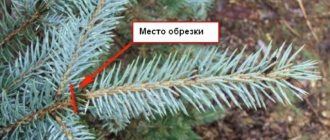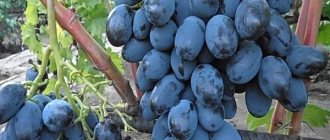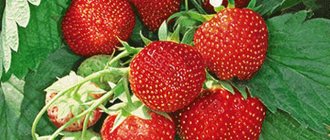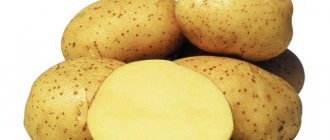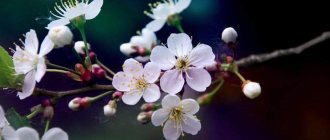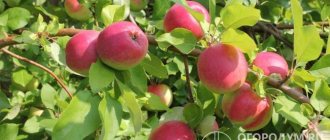Loading…
Loading…
Actinidia is becoming increasingly popular in gardening stores, the cultivation and care of which is very simple, and the result is pleasant. From the bush you can collect at least 20 kg of tasty fruits, depending on age. What is this? In order not to be verbose, let's say that one of the varieties of this plant is kiwi. So how should you care for your miracle relative to get a big harvest?
Brief information about actinidia
Actinidia is an ornamental and medicinal shrub vine that brings a bountiful harvest every year.
The homeland of the plant is China. In the Primorsky Territory of the Far East you can often find wild actinidia, on the basis of which many winter-hardy varieties have been bred that can grow and bear fruit in our conditions. Most often, we encounter the plant not in the form of a bush, but in the form of fruits, which include kiwi. Due to their variegated leaves, actinidia are often planted in gardens for vertical gardening of verandas, houses, gazebos, pergolas, fences, and trellises. The plant is especially beautiful during the period when many buds bloom (early June). In August-September, large fruits weighing 13-18 g appear in their place.
Fruits can be eaten fresh, or made into jam, compote, marmalade, marshmallows, or added to baked goods. Sun-dried fruits taste somewhat like raisins.
Preparing for landing
Growing and caring for actinidia requires a number of manipulations on which the proper development of the plant depends. Due to the vulnerability of the root system, those seedlings that have it covered are purchased.
Actinidia should absolutely not be left with its root system exposed in the heat or wind.
You should buy seedlings of three years old or more. Moreover, these should be both male and female specimens in a ratio of 1-2:5, respectively, since actinidia is a dioecious plant and cross-pollination is possible only between plants of the same species.
The sex of the plant is determined by the structure of the flowers during the first bloom. The male specimen has buds with many stamens, but they lack a pistil. In addition, the flowers form inflorescences of 6 or more buds. Male plants are characterized by a dark green color on the upper side of the foliage, which during the summer becomes white with pubescence, and then pink-red.
The female plant has both stamens and a pistil, but the former do not participate at all in pollination. Flowers receive pollen from the wind, bees and bumblebees. Unlike the male plant, the buds here are single. As for the color of the foliage, by autumn the female bushes change it to brownish.
The buds are laid in the axils of the leaves on the branches of the current year. The duration of flowering is 10 days, after which ovaries form in place of the buds on the female plants, from which fruits of a light orange or yellow-green hue develop.
Common types
There are three main groups that determine exactly what actinidia will look like, how tall it will grow, and what specific appearance it will have.
Actinidia arguta (actinidia far eastern)
The most powerful of all cultivated species, reaches a height of up to 30 meters. The trunk is up to 20 in diameter, the leaves are up to 15 cm long. They have an ovoid shape, pointed, edges with small teeth. The flowers are white, fragrant, collected in inflorescences. Actinidia arguta has subspecies:
- self-fertile - resistant to cold, ripens late, in September;
- seaside - withstands cold worse, is resistant to diseases and pests;
- large-fruited - resistant not only to cold, but also to drought.
Actinidia kolomikta
More than any other variety, it is resistant to cold. Reaches 10 meters in height, trunk diameter 2 cm. Leaves reach 15 cm, their petioles are reddish, orange veins can be seen along the veins. The top of the leaf on male plants becomes white by July, then pale pink, and dark red by autumn. The flowers are white, fragrant, solitary on female vines, collected in inflorescences on male vines. Actinidia kolomikta has subspecies:
- actinidia pineapple - one of the most productive varieties, berries with a pineapple flavor, which is why the name appeared;
- Dr. Szymanowski - one of the most variegated and beautiful leaves;
- gourmet - large fruits that ripen in the summer.
Actinidia polygamum
It looks almost like Actinidia kolomikta, only smaller. It reaches a height of up to 5 meters, the trunk is up to 2 cm in diameter. The leaves are more elongated than other varieties, have silver spots, and do not turn red in the fall, but turn yellow. The flowers are white. Has subspecies:
- apricot - ripens late, resistant to cold;
- beauty - distinguished by very fragrant fruits;
- patterned - also ripens late, the fruit tastes like figs.
Actinidia purpurea (Chinese actinidia)
It grows well in the shade and bears fruit abundantly at the end of September. Does not tolerate cold well. The fruits are bright, purple, which is why the variety got its name.
Selecting a location
Actinidia is a climbing plant, so it is often planted along the walls of a house, hedges, gazebos and other buildings. In addition, this arrangement protects the plant in winter, and it rarely freezes.
In their natural environment, actinidia prefer the “openwork” penumbra of sparse forests, so when growing plants in the garden, it is advisable to choose a place with identical conditions and protect them from direct sunlight.
Actinidia does not like places where water stagnates for a long time, so it is not recommended to plant it under drains and in tree trunks.
Correct fit
Caring for actinidia in the spring involves proper planting. The plant is undemanding to soil. In its natural environment, it grows in soil with a low content of phosphorus and nitrogen. Alkaline and clay soils are completely unsuitable. Sour, slightly acidic, or at worst neutral are preferred. This explains the impossibility of using lime as a fertilizer. It is preferable to plant plants in the spring, but it is also possible in the autumn 2-3 weeks before frost.
Autumn planting is carried out only for plants of the 2nd-3rd age.
For planting, dig holes 60*60 cm, putting 10-15 cm of drainage in them (pebbles, expanded clay, crushed stone). Add rich soil to each hole by mixing 2-3 tbsp. wood ash, 10 kg of humus and 0.15 kg of superphosphate.
It is strictly forbidden to introduce lime or manure!
As soon as the earth settles, they begin to plant the plants, having first poured a hill of soil that does not contain fertilizer into the hole, on which the seedling is placed. There should be a distance of 1.5-2.5 m between the bushes. After planting, the seedlings are watered (about 2-3 buckets per unit), the soil is lightly pressed down so that the root collar is level with the ground. The top is mulched with peat, sawdust, compost, and pine bark.
Supporting the plant vertically
After planting, it is immediately necessary to install supports for actinidia (frames, trellises) - two-meter concrete or wooden, between which a wire is stretched in 3-4 rows. Orient the support frame from east to west. The plants are placed on the south side, forming on a support in the form of a ridge or fan.
N. Kozak “Actinidia: planting is the beginning of all beginnings”
Actinidia: planting – the beginning of all beginnings
Natalya Kozak, Candidate of Agricultural Sciences
Purchase of seedlings
Actinidia planting material can be purchased in nurseries, at various fairs and markets. However, when buying seedlings, you need to remember a few simple rules.
1. Actinidia has a very vulnerable root system. Plants left with bare roots in the wind or heat even for 5-10 minutes may die, and those that survive have difficulty adapting after planting and are stunted for a long time. Therefore, you need to purchase seedlings with a closed root system: with a lump of earth, in a container or securely packaged in bags, and no older than 3 years.
2. Since actinidia is a dioecious crop, it is necessary to purchase both female and male plants. Otherwise you won’t get fruiting. It is recommended to plant 2 male plants for 5 female plants. It should be borne in mind that pollination of actinidia kolomikta, argut and polygam occurs only by plants of their own species. Mutual cross-pollination is possible only between male and female plants of actinidia arguta, giralda and purpurea.
3. Before flowering, it is impossible to determine the sex of actinidia by external signs. Therefore, purchase planting material from nurseries and not from the market.
4. Seedlings grown from seeds (seedlings) may not retain varietal characteristics. It is more prudent to purchase planting material grown from cuttings. They can be distinguished by external signs. In seedlings grown by cuttings, thin young shoots grow from the lateral buds, and the stem itself has the appearance of a stump. The seedling forms the main axial shoot, growing from the apical bud.
5. Actinidia kolomikta seedlings are most often sold. They are easily distinguished by the appearance of a one-year-old woody shoot. Its color is rich, varying from tobacco, greenish-brown to reddish-brown, almost chocolate. Small, round, convex, light lenticels are clearly visible on the bark. Because of them, the shoot feels rough to the touch. In other types of actinidia, the shoots are smooth, light, greenish, sandy or brownish shades predominate.
Selecting a location
Since actinidia grow in the open penumbra of sparse forests in their natural habitat, it is advisable to choose a place with similar conditions. But on a garden plot, which is usually small, at first glance, it is simply impossible to find such a place. Therefore, let's think together about where it is best to place the purchased vines.
First of all, it is worth remembering that climbing plants need supports on which they will grow in a vertical plane. This means that they will not take up a lot of garden space. Actinidia can be placed on trellises around the perimeter of the garden and along the walls of a house or other outbuildings. It is also suitable for creating gazebos, green canopies and hedges.
We should not forget about the decorative nature of actinidia. The vines are attractive all year round; in winter with the intricate interweaving of branches against a background of snow, in spring with the bright greenery of young foliage, during the flowering period with the delicate aroma of flowers. By mid-August, the leaves of Actinidia kolomikta, starting from the edge of the leaf blade, acquire reddish-brown shades.
Mature arguta plants present a vibrant, satiny, iridescent wall of dark green during the summer, turning bright yellow in the fall. On polygamy, from the beginning of September, among the velvety shimmering light green and already yellowed leaves, orange berries ripen, which do not fall off even after the first frost. To constantly admire this beauty, it makes sense to plant several actinidia in plain sight - at the entrance to the house, near a window or near a path.
The question is often asked: “Is it possible to plant actinidia on the north or south side of buildings?” The answer to this is ambiguous. These plants are shade-tolerant, but can bear fruit well only with sufficient light. Therefore, it is preferable to place vines against a wall facing east or west, in partial shade or where direct sunlight reaches at least half the day.
Actinidia planted on the north side of the building can also grow and develop quite well. Since the snow does not melt here in the spring longer, this somewhat slows down the opening of buds and the growth of young shoots, which protects them from freezing during late spring frosts. However, such plants begin to bear fruit later - when their shoots reach a height where nothing blocks the sunlight.
When actinidia are grown south of a building or in an open space, as many years of observations have shown, the plants do not suffer from sunburn of leaves, shoots or fruits. However, with this placement it is important to prevent overheating and drying out of the upper root layer of soil. This is quite achievable through timely mulching of the soil and watering, and regular spraying of foliage in the morning and evening.
According to the rules, in the North-West region it is not recommended to plant actinidia on the south and south-west sides of buildings, in the southern regions - on the north-east and north.
What kind of neighbors does actinidia like? For plants, especially young ones and growing in the sun, the proximity of annual legumes is very beneficial: beans, peas, and even better - beans. Sown in close proximity to the vines, they improve the soil while preventing it from drying out and creating a suitable microclimate.
Flowers planted nearby as a living backdrop are welcome. You can create a bright mixborder from annuals: petunias, asters, verbena, ageratum, matthiola, calendula, godetia, clarkia, antirrinum, tagetes and other flowering plants that are quite powerful, but do not dry out the soil.
As a rule, next to the wall of a residential building, actinidia better tolerates harsh winters and rarely freezes during frosts in late spring and early summer. However, when planting near buildings, it is necessary to take into account where water drops from the roof fall so that they do not damage young plants.
Like many plants, actinidia grows well in places protected from the prevailing winds in the area. Again, buildings or tall, dense plantings can be used as protection.
When placing a large number of plants, they are planted in rows with row spacing of 3-4 m and at a distance of 1.5-2 m between seedlings. The rows are placed in the north-south direction, which contributes to longer preservation of snow and moisture of the cololianas, and in the summer to uniform illumination and successful shading during the hottest hours of the root collar and the zone of greatest spread of roots.
Actinidia is undemanding to soil fertility. In nature, it grows normally on lands with low levels of nitrogen and phosphorus. However, it should be borne in mind that alkaline soils are not suitable for it. Slightly acidic and acidic are optimal, although neutral ones are also acceptable. Therefore, before planting actinidia, the soil is limed. Otherwise, the vines will suffer, develop worse, and may even die. Heavy, floating, clayey soils with close groundwater levels are also undesirable.
When choosing a site for actinidia, you should also take into account that it does not like places where melt and rainwater lurk for a long time, as well as planting fruit crops in tree trunks. In the first case, the plants become wet and die; in the second, they suffer from drying out the soil by powerful tree roots and from damage to the surface root system during deep tillage of the soil in the orchard. The close proximity of an apple tree is especially undesirable for actinidia. If a young fruit tree is used as a support, it often dies, strangled by the vine.
For actinidia, the proximity of hazel and currants is desirable. The latter is also good as a previous culture.
Landing.
The best planting time is spring or early summer. But you can plant it in the fall, 2-3 weeks before the first frost. 1-3 year old vines are planted in a permanent place, because older plants tolerate replanting very poorly.
Having chosen a place suitable for actinidia, 2 weeks before planting, prepare planting holes with a depth and diameter of 50-70 cm, or dig a trench 50-60 cm deep, 40-50 cm wide. Drainage from pebbles and gravel is laid at the bottom in a layer of 10-15 cm , broken brick or expanded clay, but it is best to use coal slag for this purpose.
Fertile garden soil mixed with mineral fertilizers and humus is poured on top. The following is added to each planting hole: 8-10 kg of humus, 200 g of superphosphate, 50 g of ammonium nitrate, 70-80 g of potassium salt. Instead of potassium salt, if possible, it is better to use the same amount of potassium sulfate or 2-3 cups of wood ash. We remind you once again that lime, like fresh manure, cannot be added to the planting hole.
When the ground settles, begin planting. 5 cm of fertile soil without fertilizers is poured on top of the dressing mixture (to avoid burning the tender young roots), a mound is made and a seedling is placed on it without destroying the lump of earth around its root system.
Before planting, an actinidia seedling with a closed root system must be watered abundantly and only then removed from the container.
After planting, actinidia is watered and the soil is carefully compacted around it, making sure that the root collar is not buried, but at ground level. There is no hole around it to prevent rainwater from accumulating there. After watering, the soil is thoroughly mulched. Actinidia seedlings are not pruned either before or after planting, as is often done with other fruit plants. While the plants take root (10-15 days), they are covered from direct sunlight with a light cloth or paper.
Since the smell of all types of actinidia attracts cats, like the smell of valerian, plants immediately after planting should be fenced with a metal mesh, dug into the ground to a depth of 5 cm. The shoots and roots of actinidia polygamum are especially affected by cats.
In dry weather, new plantings are mulched several times during the summer to maintain a loose, moist surface layer of soil around them; the foliage is sprayed in the morning or evening; if necessary, shaded with gauze from hot sun rays, especially during the first 2 years of life on the site. Remove weeds regularly. The soil around is loosened carefully, taking into account that the densely branched root system of actinidia lies at a depth of up to 30 cm. For the winter, the seedlings are covered with fallen leaves (a layer of 10-15 cm) and protected from rodents with spruce branches.
Caring for fruiting actinidia vines
Mulching and loosening
Every year in the spring, immediately after the snow melts, the soil around the actinidia is loosened and covered with humus, compost, straw and sawdust, which have lain in the open air for at least a year. Several times during the summer, soil is added to the stems to prevent the root collar from being exposed. In autumn, the soil around the plants is not dug up, but carefully loosened to a depth of 3-7 cm.
Watering and fertilizing
Actinidia need to be watered frequently because the soil around the root collar must be constantly moist. Leaves also require a lot of moisture. The fact is that for the growth and normal development of vines, high air humidity is necessary. Therefore, in dry weather, actinidia are sprayed. It is advisable to do this in the morning and evening.
In the first half of summer, 1-2 liquid feedings are carried out with mullein infusion diluted 1:10, green fertilizer from weeds filled with water and fermented in a barrel, or a solution of chlorine-free mineral fertilizers (for example, 30 g of azofoska per 10 liters of water).
Trimming and shaping
In early spring and during the period of active spring sap flow, actinidia should not be pruned. Plants weaken due to sap leakage and may die. Actinidia are not pruned at the end of summer either. At this time, pruning, pinching and mechanical damage to the shoots cause the awakening of buds on the shoots of the current year. The resulting young branches do not have time to ripen and become woody, so they die after the first frost.
When can pruning be done? During flowering, immediately after it and in late autumn after leaf fall. During this period, plants are formed and thinned, weakened and drying branches are cut out. The frozen ends of the shoots are removed, which, by the way, are better visible not in spring, but in early summer.
The formation of actinidia depends on the region of cultivation, planting site and type of support. In the middle zone, it is usually grown as a bush on a vertical flat trellis, using a fan formation.
After planting the actinidia in a permanent place, select 2-4 vertically growing long shoots; these will be the sleeves - the main branches of the fan. The rest are cut down to the ground. After leaf fall, the top of the remaining shoots is removed to the level of mature wood (or the apical bud, if it has formed).
Next season, side shoots grow from the main shoots. In summer, the most powerful ones are selected and tied horizontally to the trellis, pointing in different directions. Pruning and pinching at this time is used to maintain optimal density and the desired length of the branches.
In the spring of next year, shortened fruiting shoots of mixed type are formed. They are tied vertically to the trellis. Next year, the strongest ones are again selected from the shoots growing on them and tied horizontally along the second wire, pointing in different directions. Fruit-bearing shoots are shortened every year, leaving 4-5 buds above the topmost berry. The cuts are covered with garden varnish.
In the future, pruning comes down to thinning and removing dead branches. In this case, it is necessary to take into account the species characteristics of actinidia. In kolomikta and polygamy, fruit-bearing buds for the next season are laid on both shortened and long shoots. If you prune them, next year's harvest will be significantly reduced. In arguta, fruiting occurs mainly on shortened shoots. Therefore, more intensive thinning is applied to it in combination with pinching and short pruning.
In addition, in Actinidia kolomikta, from the age of 7-10 years, one of the old main branches is annually replaced by a young strong shoot. And in Actinidia arguta, the main vine usually lasts throughout the life of the plant; it is replaced only in case of mechanical damage or freezing.
Supports and garter
In amateur gardens, for the convenience of caring for plants and collecting fruits, vines are not allowed to climb too high. The recommended trellis height is 3.5 m.
Possessing continuous growth, powerful and durable actinidia vines in one place can produce crops for 50 years or more. Therefore, they need strong and stable support from metal or reinforced concrete pillars. 4 rows of galvanized wire are stretched between them: the first 50 cm from the ground, the rest after 100 cm.
During the growth process, the shoots are tied to one side of the trellis. Twine is used for garter. The shoots are tied in a figure eight. By the time the vines grow and, intertwining, wrap around the wire, the twine will disintegrate under the influence of sunlight and will not prevent the stems from thickening.
The described trellis is well suited for growing actinidia in areas with a temperate climate. Its advantages are uniform illumination of the branches, ease of care for vines and soil cultivation. Where winters are very cold, a trellis that can be laid on the ground in the fall is better suited.
Such a trellis is constructed from a metal corner or pipes, which are inserted into scraps of pipes of larger diameter buried in the ground. Cut 2-3 through holes and secure with bolts or cotter pins.
In the south, for tall species of actinidia (arguta and purple), more voluminous T, G, and U-shaped trellises are used.
Harvesting
The ripening of Actinidia kolomikta fruits occurs unevenly, from the end of July and throughout August. Ripe berries often fall off. Therefore, it is better to harvest the entire crop at once, when the first berries are ripe, put them in boxes and move them indoors for ripening. Usually they ripen within 3-5 days, without their quality deteriorating.
If Actinidia kolomikta has grown so large that its upper shoots cannot be reached, spread a cloth under the vines and collect the ripe fruits that have fallen from above.
Following kolomikta, the fruits of giralda and arguta ripen at the end of August – beginning of September. They acquire a rich green color and, gradually softening, become tender, melting in the mouth, with a taste and aroma characteristic of each variety.
In September, the fruits of Actinidia polygamum and purpurea ripen. Polygamy berries first turn yellowish, then various shades of orange. Actinidia purpurea, which has bright purple fruits, ripens later than other species.
Unlike kolomikta, the harvest of these species is almost never shed. Therefore, their fruits, as a rule, are not ripened, but are collected as they ripen. But if there is a threat of early autumn frosts, it is better to immediately harvest the crop. In the room, the fruits will ripen, become soft and fragrant.
The material was published in the library of the newspaper “Gardener’s World” “Garden. Garden. Flower Garden", No. 12, 2010
https://www.mirnov.ru/ms.html
https://www.greeninfo.ru/fruits/actinidia_kolomikta.html/Article/_/aID/5184
Actinidia care
Care includes watering, fertilizing, mulching and pruning. To moisten the plants, they should be sprayed well in the morning and evening. It is especially necessary to carry out the procedure in hot weather.
Growing and caring for actinidia during a long drought is as follows. To prevent the plant from losing its foliage, it is watered every week with 6-8 buckets of water per unit. Otherwise, after dropping leaves, the plant cannot grow new ones and will freeze in winter.
The procedure of tree-trunk loosening is carried out frequently, while simultaneously weeding, but not very deeply, so as not to damage the root system.
It is important for actinidia to receive fertilizers, as this increases its frost resistance, stimulates the growth of young shoots and helps increase productivity. The question of how to feed actinidia in the spring is resolved quickly.
In early spring, phosphate-, nitrogen- and potassium-containing fertilizers are applied in a ratio of 20:35:20 g per 1 m². When the fruits begin to set, a second “feeding” is performed, applying similar fertilizers, but in a ratio of 10-12/15-20/10-12 g per 1 m². The last feeding is carried out in mid-September, when the harvest is harvested, using a mixture of phosphorus and potassium, 20 g each. The fertilizer should be evenly distributed over the soil, and then dug to a depth of 10-12 cm and water each bush generously.
Trimming
To prevent thickening of the crown, pruning is carried out.
The procedure is performed only for actinidia that have reached 3-4 years of age.
Manipulations are carried out throughout the summer, after which the branches are placed on the actinidia support in the desired direction. They also do pinching, which stops the growth of branches.
To rejuvenate 8-10 year old plants, old skeletal branches are pruned, leaving only a stump of 30-40 cm from the vine.
Actinidia are not pruned in spring and autumn due to strong sap flow. Otherwise, the plant will die.
With the onset of autumn, young 2-3 year old vines are removed from their supports and covered with peat, dry leaves, spruce branches, at least 20 cm deep, after putting poison for rodents so that they do not dig nests. Adult actinidia do not need to be covered.
Transfer
When planting, an interval of 1.0-1.5 m is left between plants. Fruiting by vegetative propagation begins in the 4th-5th year, earlier than with seed propagation. Productivity is significantly increased by high agricultural technology - weeding the soil under the plant, loosening and watering. Pruning and shaping bushes comes down to removing broken, diseased, old and thickened shoots.
Actinidia can also be propagated by lignified cuttings cut in early spring before sap flow begins. Rooting rate - 50-70%.
Actinidia are planted in pits measuring 1.0 x 1.0 x 0.6-0.7 m. The pit is filled with manure or leaf humus mixed with matured turf and peat. It is useful to feed fruit-bearing plants with slurry. The plant should not be allowed to become bushy: usually 1-2 branches (sleeves) per bush are left in the culture.
So, actinidia will grow well and bear fruit in the presence of 4 main conditions: partial shade, good soil, moisture and support.
Reproduction
If you start growing a plant, then sooner or later you will be interested in how to propagate actinidia. The propagation process is quite simple, so a gardener can independently grow both male and female specimens. In this case, the gender and characteristics of the variety are inherited from the parent to the child (except for the use of the seed method).
Arc layering method
At the end of the spring sap flow and the blooming of young foliage, the longest and most well-developed growth shoot is selected, tilted downwards with the tip and attached to the ground, sprinkling the pinning area with a 10-15-centimeter layer of soil. The hill should be watered and mulched with sawdust or humus.
In the fall or spring of next year, the cuttings and the mother bush are separated, and the baby is transplanted to a permanent location.
Cuttings
Gardeners are often interested in how to propagate actinidia from cuttings in the spring. This is done in two ways.
Cuttings from green shoots
With the onset of June, several strong annual branches 0.5-1 m long are selected, cut in the morning and immediately placed in a jar of water to prevent wilting. Each twig is divided into fragments of 10-15 cm and planted in soil (slightly acidic or neutral), into which humus and river sand are previously added in a ratio of 1:2, as well as mineral complex fertilizer that does not contain chlorine (100 g is enough for 1 m²) .
Planting is carried out at an angle of 60º, maintaining a distance of 5 cm between cuttings and 10 cm between rows. In this case, the middle bud on the branch should be located at soil level. The soil around the cutting is compacted, watered, and a two-layer gauze is placed on top, which is removed after 2 weeks.
Before the onset of winter, the cuttings are hidden under fallen leaves, and in the spring, before the foliage blooms, they are transplanted to a permanent place of growth.
Lignified cuttings method
According to this method, actinidia propagation is carried out as follows. Lignified cuttings are cut in late autumn, tied into bunches and stored vertically until spring in a box filled with sand at a maximum temperature of 1-5 ºC. Planting is carried out in a greenhouse and watered once every two days. They are cared for like green cuttings.
Seed method
After mashing the ripest whole fruits and then washing them, the resulting seeds are dried on paper in the shade. Then, in the first ten days of December, they are soaked for 4 days, filled with 2 cm of water, stratified and sown 0.5 cm deep in containers filled with a mixture of turf soil and river sand.
Seedlings should be sprayed and protected from direct sunlight. After 3-4 leaves appear, the young plants are transplanted into a greenhouse. Flowering occurs upon reaching 3-5 years of age, after which the plant is transplanted to a permanent place in the ground.
Description
Actinidia purpurea is an amazing plant of the liana family, which appeared in our country from Chinese forests. But only thanks to the hybrid crossing of breeders, it nestled in the central regions, since it was initially heat-loving. Selection work to increase the winter hardiness of actinidia continues.
Actinidia has medicinal properties, and in terms of vitamin C content it is in second place after rose hips. When the berries are visible, it looks amazing - purple berries against a background of green foliage.
Actinidia arguta Purple Garden is a vine that entwines support structures higher than three meters with its bending brown stems. Oblong leaves in the shape of an ellipse of green color, with a pointed tip. The lower ones are drooping and have short whitish hairs. Actinidia arguta Purple Garden comes in two sexes. On females there are flowers of two sexes with a large pistil in the middle, which is surrounded by small stamens. In males, only staminate flowers are present. They are pollinated by insects - bumblebees, bees.
Fruit ripening occurs in September. The small berries are up to three centimeters long and weigh a maximum of eight grams. They are cylindrical, shiny and purple in color with a dark tint. The pulp of the berry is also purple, sweet, juicy, with amazing aromatic notes and a large number of very small seeds. The berries hold tightly to the stems and do not fall off.
Actinidia prefers to grow on loamy, well-drained soils with high humidity, but does not tolerate stagnant water and does not like dryness. They should be planted in sunny places, but perhaps in slightly shaded ones. Propagated by seeds and cuttings. The seeds are taken out from the fruit, dried, placed in nylon bags, placed in sandy, moist soil for two months and for the winter they are lowered into a basement with zero temperature until spring. In the spring, they are sown in the shade, watered abundantly, and then the rooted shoots are pricked up. The next spring, the seedling is planted in a permanent place. The earth is plowed thirty centimeters deep with mineral fertilizers, potassium, phosphorus and organic fertilizers.
Diseases and pests
Plants are quite resistant to diseases and are rarely attacked by pests. If the rules of care are followed when growing actinidia, the bushes become practically invulnerable.
Among the diseases, the plant can be affected by phylostyctosis, fruit rot, powdery mildew, green or gray mold, and fungal diseases that cause spots on the foliage. If problems arise, the diseased parts of the plant are removed. For preventive purposes, plants are treated with Bordeaux mixture (1%) immediately after the appearance of buds. The procedure is repeated again after 2 weeks. To combat powdery mildew, double treatment (with a break of 10 days) of baking soda (0.5% solution) is carried out.
Among insects, leaf beetles and their larvae, which eat buds, foliage and fruits, as well as lacewings, caterpillars of the sultana moth, and bark beetles cause great harm to the plant. Relief is brought by spring and autumn treatment of the soil and the entire plant with Bordeaux mixture, which kills wintering or wintering pests and their larvae.
Oddly enough,…cats are also considered pests. After the snow melts, animals dig up the roots, thereby damaging them, and also eat young shoots. Therefore, as soon as the plants have been planted, they must be protected with a wire fence, buried 10 cm into the ground and making some kind of cover so that cats cannot penetrate through the top of the tree.
Proper care of actinidia will help to grow a healthy shrub, which will subsequently generously reward you with a large harvest of delicious fruits.
Support points
For thin stems of annuals, light and elegant support structures made of wire, plastic tubes, rods, and thin fittings are suitable. They do not need a foundation (supporting posts buried 30–50 cm into the ground are sufficient); for the winter they can be removed indoors, and in the new season they can be installed in a different place to “refresh” the landscape. Fiery red beans or sweet peas will look organic on a decorative mesh made of flexible willow or walnut twigs.
Photo: Legion-Media
Moorish bindweed grows quickly, can form a kind of hedge and at the same time blooms beautifully and for a long time - at least 1.5 months
Trellis for perennial vines are installed before planting, so as not to damage the roots later. The cell sizes are selected depending on the type of plant (for example, clematis needs 15 × 15 cm cells, and grapes need 30 × 50 cm cells). For climbing vines, it is important to take into account the thickness of the support (for example, for actinidia it should be no more than 7 cm). The foundation of trellises and pergolas can be pieces of steel corners or pipes driven (dug) into the ground to a depth of about 1 m; such a foundation is sufficient to prevent the structure from being knocked over by the wind.
To support the grapes, wire loops can be attached to the structure; they will hold the vine at a distance of about 5 cm from the wall, providing the plant with good ventilation and protecting it from damage by fungal diseases.
A specially shaped wire frame, braided with vines, turns into a garden sculpture. In addition, the composition can be based on a dried tree, a tall stump or an alpine hill.

